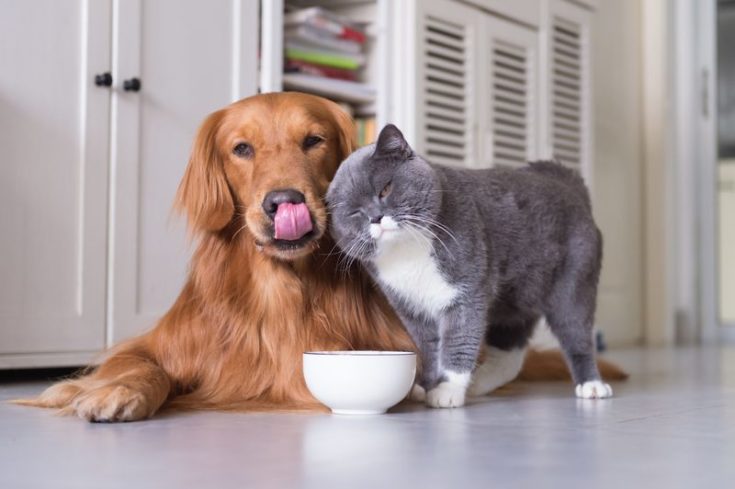
Click to Skip Ahead
Determining what is in your pet’s food is important. Not only will it give you a good indication of what types of foods your pet is eating daily, but it will also help you determine if this type of food is benefiting your pet nutritionally. Reading the labels can be tricky, and many pets food brands do not go into much detail about the significance of the ingredients to your pets. In some cases, reading the labels can be extra tricky because the manufacturers used scientific names for the ingredients.
We have put this article together to help you read and understand pet food labels so that you do not have to go through the confusion of trying to make sense of figuring out how to read and identify certain aspects of your pet’s food.
How To Read Pet Food Labels
1. Product of brand name.
The product name will be the largest printed area on a pet food label. You will easily be able to determine the brand of pet food you are looking at. Depending on the type of pet food there may also be a second heading where it can classify what target area this food has been formulated for, such as food for senior dogs or cats. This will also help determine what the overall food’s nutritional content will be targeted towards.

2. Quantity of the product (weight or volume).
The quantity and volume of the product will appear in a corner on the front and back label of the food. This will show how much the contents weigh which can help you determine how long the food will last. You can also do a cost-per-pound test to see if this food reaches your value for money standards.
3. The guaranteed analysis or nutritional content.
Many states will have a regulation stating that the manufacturer must give a clear indication of the minimum number of nutrients the pet food contains. The guaranteed analysis is typically calculated on the FDA website. This section on the label will be in table format and provide you with percentages, pounds, and certain calories each component contains. Such as the minimum and maximum fat percentage if the food is labeled as ‘low-fat’.

4. Ingredients in ascending order according to weight.
The ingredient list is the most important part of the label as it will indicate what ingredients and additives or preservatives are in the food. The first ingredient on the label occurs in larger quantities than other ingredients that follow.
5. Feeding directions.
The feeding directions will explain how much of the food to give your pet according to their weight. Sometimes this part of the label will go into detail and take your pet’s age and life stage into account as well. The Association of American Feed Control (AAFCO) is usually certified to show that the feeding guidelines have been professionally considered for your pet.

6. Manufacturer’s certification and address.
The certification label will tell you if the food has been evaluated and approved by a registered organization for pet food. Some common examples of certification on dog and pet food labels are CE, FDA, or ISO. Vets, nutritionists, and pet food manufacturers are required to provide certification on your pet’s food so that you know it has been tested and regulated by a reputable source.
7. A calorie statement.
The caloric statement roughly applies to the amount of fat found in the food and in some cases the non-calorie-containing ingredients such as water and fiber. The calorie statement should be expressed as ‘kilocalories per kilogram’. However, the metric unit will vary depending on the product manufacturing state. The calorie statement will give an approximate value of how many calories (kcal) are in the pet food per cup or serving.

How To Read Ingredient Lists
The ingredients must be listed in descending order according to weight. The ingredients are listed individually and according to the AAFCO regulations, the terms describing a collective of ingredients should not be labeled as ‘animal protein products’ because it does not indicate specific ingredients that are incorporated into the pet food. The ingredients should be listed by their common or unusual name and the AAFCO has a detailed list of ingredients, their common names, and what they contain.
By-products are also a common additive in pet food in the form of blood, brain, bone, stomach, and liver from the animal listed as the main ingredients. These by-products will typically fall under the name of ‘meat meal’ or any protein-based food with the word ‘meal’ at the end. Pet food will typically have a chicken, fish, beef, or vegetable label which can give you a good indication of what the main ingredient in the food will be. Chicken is a common flavor enhancer and ingredient in both cat and dog foods. Rodent foods (such as hamsters or guinea pigs) will not usually have a second heading labeling the main ingredient or flavor of the food.
Analyzing the ingredient label
The first ingredient on the label shows the ingredient that has the largest value in the food. The first sentence on the ingredient label will show the most active and prominent ingredients in the food. As the last few ingredients at the bottom of the list occur in small values and do not make up a large portion of the food.
Here is an example of an ingredient list on Hill’s Science Selective Sensitive dog food:
Chicken, Brewers Rice, Chicken Meal, Yellow Peas, Cracked Pearled Barley, Whole Grain Sorghum, Egg Product, Chicken Fat, Soybean Oil, Brown Rice, Dried Beet Pulp, Chicken Liver Flavor, Lactic Acid, Pork Liver Flavor, Potassium Chloride, Flaxseed, Iodized Salt, vitamins (Vitamin E Supplement, L-Ascorbyl-2-Polyphosphate (source of Vitamin C), Niacin Supplement, Thiamine Mononitrate, Vitamin A Supplement, Calcium Pantothenate, Riboflavin Supplement, Biotin, Vitamin B12 Supplement, Pyridoxine Hydrochloride, Folic Acid, Vitamin D3 Supplement), Choline Chloride, Taurine, minerals (Ferrous Sulfate, Zinc Oxide, Copper Sulfate, Manganous Oxide, Calcium Iodate, Sodium Selenite), Mixed Tocopherols for freshness, Oat Fiber, Natural Flavors, Beta-Carotene, Apples, Broccoli, Carrots, Cranberries, Green Peas.
Chicken and brewer rice are the main ingredients in this pet food. This is also the flavor of the food and occurs in a large percentage which is why it’s at the top of the ingredients list.
Green peas make up the smallest portion of the food because it is last on the ingredients list. Traces of these ingredients are found in this food.
Chicken meal is a by-product ingredient and the actual ingredient in this meal is not specified. However, it is most likely chicken liver and waste products which have nutritional benefits such as Vitamin A.
The supplements and additives are more difficult to read because it has been labeled under a scientific or unusual name. This part of the ingredient list is not overly important, but it is necessary to ensure that these hard-to-read ingredients do not match a harmful dog or cat ingredient. It is best to skim-read the ingredients and ensure that most of the ingredients are easy to understand.

What Is a Guaranteed Analysis Of Pet Food?
The guaranteed analysis is an important part of the pet food label. This will give you a good indication of the maximum (max.) or minimum (min.) amount of fiber, fat, protein, and moisture content in the food. The guaranteed analysis is the nutrient profile, and it divulges the diet’s basic nutrient composition. It shows the guaranteed percentage of nutrients your pet will get when eating this food.
The Guaranteed analysis of Hill’s Science Selective Sensitive dog food:
| Crude Protein: | 21.0% min |
| Crude Fat: | 12.0% min |
| Crude Fiber: | 4.0% max |
| Moisture: | 10.0% max |
The minimum value beside the nutritional percentage indicates the minimum amount of crude fat, protein, or fiber that is found in the food. Whereas the max value indicates the maximum amount of moisture in the pet food. In some cases, the word ‘crude’ is not put in front of the protein, fat, or fiber content. ‘Crude’ protein is a measurement used to inflate the amount of protein in the food.
Pet food manufacturers use crude protein content to calculate the number of carbohydrates in the food. It is a mixture of protein molecules that have already been divided into units called peptides. These crude protein molecules are released when the animal digests carbohydrates, lipids, and fats consumed within the food.
Understanding the Descriptive Terms
There are many new enticing subheadings on the food used to draw in buyers to natural or senior-based pet food, but what exactly does this mean on a pet food label?
Organic: The U.S. Department of Agriculture (USDA) is developing some regulations specific to the labeling of organic foods for pets. If a pet food claims to be organic, the food should be able to meet the ingredient, production, and handling requirements according to the USDA’s National Organic Program to be officially considered organic.
Most high-quality commercial dog foods meet the AAFCO’s nutritional guidelines and list fillers last on the ingredients list. There is some debate about whether ‘organic’ is the same as ‘natural’, but these two labels have their differences. Natural refers to the conditions under which the plants were grown or the way the animals were raised.
Grain-free: Some dogs or cats with food sensitivities seem to do better on grain-free pet foods. This is because grains can trigger digestive issues or potential allergies. Grain-free pet foods exclude all forms of grains and their by-products, such as rice, barley, and wheat. Not much is known about the health benefits for pets on a grain-free diet, but some pets seem to do better on these formulas.
Human-grade dog food: This label defines the food as legally edible and approved as a form of nourishment for humans. It is generally regulated by the FDA and USDA. According to the AAFCO, for a product to be edible by humans, all the ingredients found in the food should be manufactured, packed, and held by federal regulations. It does not mean the food is a substitute for a human to eat, nor does it make it safer or tastier than other pet foods.
New proteins: It does not necessarily mean that the protein ingredients are completely new, but rather that they are a more fancy and uncommon form of protein used in the food. This can include proteins and their by-products from bison, kangaroo, rabbit, and any other exotic animal. This is a good substitute for dogs that struggle to digest more common proteins like chicken or beef.
Lite, low-calorie, or low-fat: For a pet food to officially use these terms, the food should have a noticeable reduction of calories or fat when compared to standard pet foods. The AAFCO requires these descriptive terms to be true to the name and the reduction percentage in calories or fats should be clearly shown. These types of foods are considered ‘better’ for obese dogs or cats, because the lack of calories and fat may have some significance to weight loss.

Quality vs Questionable Ingredients In Pet Food
Quality ingredients are foods included in the food that have well-known health and nutritional benefits for the animal. In terms of dog and cat foods, proteins are sought after as these animals eat a meat-based diet. Questionable ingredients are foods that should not be included in the food because they are deemed nutritionally insignificant or unnecessary. Fillers and additives are a good example of questionable ingredients as there’s no benefit to having them in your pet’s food.
What Are The 4 Pet Food Label Rules?
Should a Pet Food Be Certified?
Pet food certifications are used in the food industry to provide more information to buyers about the way the food has been produced. The AAFCO does not directly approve or endorse pet foods and has no regulatory authority. However, the food can be tested and developed by certified veterinarians, but pet food doesn’t need to be approved by an organization for the food to be high-quality or safe. Therefore, certifications are not necessary but merely adds extra information into the specifics of the product’s manufacturing process.

Pet Food Calorie Calculators
If you are looking for a tool that will help you to maintain the best of your pet, then choose the best fit here:
Dog Calculator
The exact amount of calories an individual animal needs to maintain a healthy weight is variable and influenced by many factors including genetics, age, breed, and activity level. This tool is meant to be used only as a guideline for healthy individuals and does not substitute veterinary advice
Cat Calculator
The exact amount of calories an individual animal needs to maintain a healthy weight is variable and influenced by many factors including genetics, age, breed, and activity level. This tool is meant to be used only as a guideline for healthy individuals and does not substitute veterinary advice
 Final Thoughts
Final Thoughts
Reading your pet’s food label will become easier over time. Overall, the ingredients list, guaranteed analysis, and descriptive terms (organic, grain-free) are the most important label headings to look out for on your pet’s food. By skimming over the packaging and understanding the key elements the pet food has to offer, you will easily be able to determine if the food is worth feeding to your pet.
See Also:
Featured Image Credit: Yuriy Golub, Shutterstock




 Final Thoughts
Final Thoughts



